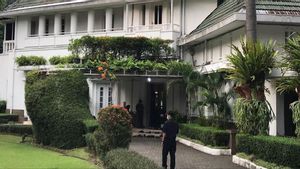
JAKARTA - Dr. Ralph Girson Ginarsa, SpPD-KHOM, specialist in internal medicine and consultant medical oncology hematology said there are several lung cancer treatment options that are tailored to the size, scope, type of lung cancer, and the patient's general health condition.
The doctor from the Faculty of Medicine, University of Indonesia said that the symptoms of lung cancer often do not appear in the early stages because the signs are similar to other common diseases such as tuberculosis or the impact of long-term smoking habits.
Not a few patients who come with lung cancer are already at an advanced stage. According to Dr. Ralph, if the patient performs an early examination, it will get better treatment results.
"For those over the age of 55 who are often exposed to these risk factors, early detection of lung cancer can be done by annual screening through imaging tests. If lung cancer is suspected, a CT, PET, or MRI scan will be carried out, then mucus testing, and further testing," Dr. Ralph said, cited from Antara, Sunday
Dr. Ralph explained that there are three main methods of lung cancer therapy depending on the size, scope, type of lung cancer, and the patient's general health condition.
For non-small cell lung cancer (NSCLC) at an early stage (stage I) where the cancer is still in one of the lung organs, the treatment can be done with surgery.
After that can be continued with chemotherapy to reduce the risk of relapse. Another option after surgery can be radiation therapy.
In stage II, the cancerous lymph nodes and the existing cancer are removed, followed by chemotherapy, and possibly immunotherapy. Another option is radiation.
In stage IIIA, NSCLC that is more than 7 cm in size or has hit the lymph tissue between the two lung organs, then the therapy is radiation, chemotherapy, and or surgery depending on the size of the tumor, location in the lung, patient's health, and patient endurance.
In stage IIIB, NSCLC has spread to lymph nodes in other lungs or to the neck or other structures in the chest. This cancer can not be removed only by surgery, but with chemoradiation.
Immunotherapy can be given if the cancer is under control after two chemoradiations. Patients who are not healthy are only given radiation or chemotherapy alone.
In stage IV, cancer has spread to other parts of the body and becomes difficult to cure. Palliative therapy is given with a focus on pain reduction such as photodynamic therapy (PDT) or laser therapy.
However, if the patient's condition is strong enough, treatment or treatment with surgery, chemotherapy, targeted therapy, immunotherapy, or radiation can be done.
Considering the long process of curing NSCLC lung cancer, Dr. Ralph appealed to the public to take precautions such as quitting smoking and early detection of lung cancer.
"Cancer can be cured if found and treated immediately by a doctor at an early stage. In addition, coupled with the application of a healthy lifestyle, eating nutritious foods, not consuming alcohol, exercising regularly, getting enough rest, and staying away from stress," said Dr. Ralph.
Dr. Ralph also reminded the public not to be afraid of early detection of lung cancer. Because early treatment can bring better results compared to being aware of cancer too late.
"Don't be afraid, because we still have memories that cancer can't be treated or it's difficult to treat and it's better to choose an alternative. The reality is different now, we already have various protocols, the equipment is also good," said Dr. Ralph.
Dr. Ralph suggested that patients who have had a habit of smoking for 20 years and have smoked to do the examination. Detection of lung cancer is also expected to be repeated every year.
SEE ALSO:
"So don't be afraid to do an examination because early detection is much better than late," he said.
Based on GLOBOCAN 2020 data, lung cancer is the cause of about 11 percent or 2.206.771 new cases of cancer. This cancer is also the number one cause of cancer death in the world, while in Indonesia it is the cause of 8.8 percent or 34.783 new cases of cancer.
Of the incidence of lung cancer, more than 80 percent are non-small cell lung cancer (NSCLC) and about 40 percent of NSCLC have epidermal growth receptor (EGFR) mutations.
After finding lung cancer, the average 5-year survival or the percentage of patients living at least five years is 21 percent. The 5-year average survival rate for men was 17 percent, while for women it was 24 percent.
The 5-year survival for NSCLC is 25 percent, compared with 7 percent for small cell lung cancer.
Chairman of the Indonesian Cancer Foundation, Prof. DR. dr. Aru Wisaksono Sudoyo, Sp.PD-KHOM, FINASIM, FACP said as many as 80 percent of lung cancer patients who came were at an advanced stage so the percentage of survival was lower.
Prof. Aru explained that it is very important to increase public knowledge about risk factors, symptoms, and special considerations in the treatment of lung cancer.
"The Indonesian Cancer Foundation (YKI) hopes that people can prevent cancer by adopting a healthy lifestyle, not smoking, and doing early detection of cancer, because cancer found in an early stage is easily treated and even cured," said Prof. Aru.
The English, Chinese, Japanese, Arabic, and French versions are automatically generated by the AI. So there may still be inaccuracies in translating, please always see Indonesian as our main language. (system supported by DigitalSiber.id)

















